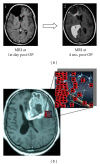Beyond Genetics in Glioma Pathways: The Ever-Increasing Crosstalk between Epigenomic and Genomic Events
- PMID: 22778947
- PMCID: PMC3385669
- DOI: 10.1155/2012/519807
Beyond Genetics in Glioma Pathways: The Ever-Increasing Crosstalk between Epigenomic and Genomic Events
Abstract
Diffuse gliomas are the most frequent brain tumor in adults. This group of brain neoplasms, ranging from histologically benign to aggressive malignant forms, represents a challenge in modern neurooncology because of the diffuse infiltrative growth pattern and the inherent tendency to relapse as a more malignant tumor. Once the disease achieves the stage of glioblastoma multiforme (GBM), the prognosis of patients is dismal and the median survival time is 15 months. Exhaustive genetic analyses have revealed a variety of deregulated genetic pathways involved in DNA repair, apoptosis, cell migration/adhesion, and cell cycle. Recently, investigation of epigenetic alterations in gliomas has contributed to depict the complexity of the molecular lesions leading to these malignancies. Even though, the efficacy of the state-of-the-art form of chemotherapy in malignant gliomas with temozolomide is based on the methylation-associated silencing of the DNA repair gene MGMT. Nevertheless, the whole scenario including global DNA hypomethylation, aberrant promoter hypermethylation, histone modification, chromatin states, and the role of noncoding RNAs in gliomas has only been partially revealed. We discuss the repercussion of epigenetic alterations underlying deregulated molecular pathways in the pathogenesis and evolution of gliomas and their impact on management of patients.
Figures




Similar articles
-
Altered histone modifications in gliomas.Brain Tumor Res Treat. 2014 Apr;2(1):7-21. doi: 10.14791/btrt.2014.2.1.7. Epub 2014 Apr 29. Brain Tumor Res Treat. 2014. PMID: 24926467 Free PMC article. Review.
-
The DNA methylome of glioblastoma multiforme.Neurobiol Dis. 2010 Jul;39(1):40-6. doi: 10.1016/j.nbd.2009.12.030. Epub 2010 Jan 11. Neurobiol Dis. 2010. PMID: 20064612 Review.
-
Epigenetic aberrations in malignant gliomas: an open door leading to better understanding and treatment.Epigenetics. 2007 Jul-Sep;2(3):147-50. doi: 10.4161/epi.2.3.5049. Epub 2007 Sep 15. Epigenetics. 2007. PMID: 18063907 Review.
-
The global DNA methylation surrogate LINE-1 methylation is correlated with MGMT promoter methylation and is a better prognostic factor for glioma.PLoS One. 2011;6(8):e23332. doi: 10.1371/journal.pone.0023332. Epub 2011 Aug 4. PLoS One. 2011. PMID: 21829728 Free PMC article.
-
Epigenomic profiling reveals novel and frequent targets of aberrant DNA methylation-mediated silencing in malignant glioma.Cancer Res. 2006 Aug 1;66(15):7490-501. doi: 10.1158/0008-5472.CAN-05-4552. Cancer Res. 2006. PMID: 16885346
Cited by
-
Inhibitory activities of trichostatin a in U87 glioblastoma cells and tumorsphere-derived cells.J Mol Neurosci. 2014 Sep;54(1):27-40. doi: 10.1007/s12031-014-0241-7. Epub 2014 Jan 25. J Mol Neurosci. 2014. PMID: 24464841
-
Cell biology of glioblastoma multiforme: from basic science to diagnosis and treatment.Med Oncol. 2018 Jan 31;35(3):27. doi: 10.1007/s12032-018-1083-x. Med Oncol. 2018. PMID: 29387965 Review.
-
Specific combinations of the chromatin-modifying enzyme modulators significantly attenuate glioblastoma cell proliferation and viability while exerting minimal effect on normal adult stem cells growth.Tumour Biol. 2015 Nov;36(11):9067-72. doi: 10.1007/s13277-015-3654-1. Epub 2015 Jun 19. Tumour Biol. 2015. PMID: 26084611
-
XRCC1 gene polymorphisms and glioma risk in Chinese population: a meta-analysis.PLoS One. 2014 Nov 6;9(11):e111981. doi: 10.1371/journal.pone.0111981. eCollection 2014. PLoS One. 2014. PMID: 25375625 Free PMC article.
-
Highly synergistic effect of sequential treatment with epigenetic and anticancer drugs to overcome drug resistance in breast cancer cells is mediated via activation of p21 gene expression leading to G2/M cycle arrest.Mol Pharm. 2013 Jan 7;10(1):337-52. doi: 10.1021/mp3004622. Epub 2012 Dec 24. Mol Pharm. 2013. PMID: 23215027 Free PMC article.
References
-
- Ohgaki H, Kleihues P. Population-based studies on incidence, survival rates, and genetic alterations in astrocytic and oligodendroglial gliomas. Journal of Neuropathology and Experimental Neurology. 2005;64(6):479–489. - PubMed
-
- Aldape KD, Okcu MF, Bondy ML, Wrensch M. Molecular epidemiology of glioblastoma. Cancer Journal. 2003;9(2):99–106. - PubMed
-
- Brandes AA, Ermani M, Basso U, et al. Temozolomide as a second-line systemic regimen in recurrent high-grade glioma: a phase II study. Annals of Oncology. 2001;12(2):255–257. - PubMed
-
- Stummer W, Pichlmeier U, Meinel T, Wiestler OD, Zanella F, Reulen HJ. Fluorescence-guided surgery with 5-aminolevulinic acid for resection of malignant glioma: a randomised controlled multicentre phase III trial. The Lancet Oncology. 2006;7(5):392–401. - PubMed
LinkOut - more resources
Full Text Sources
Research Materials

